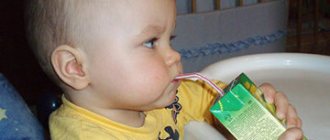Lambdacism and paralambdacism - what is it?
This term implies the incorrect pronunciation of hard and soft L. Moreover, this includes not only the distorted sound, but also the absence of a phoneme in the spoken words. Lambdacism happens:
- bilabial - the vowel “u” is heard (not “horse”, but “washed”);
- nasal - the root of the tongue touches the soft palate, the air flow goes into the nose, resulting in the sound “ng” (not “puddle”, but “nguzha”);
- interdental - the end of the tongue ends up in the space between the teeth;
- with a lack of pronunciation (not “leika”, but “eyka”).
There is also paralambdacism, when the correct pronunciation is replaced by an incorrect one. Usually replaced by:
- “G” (“floor” - “pog”);
- “B” (“ski” - “survive”);
- “Yo” (“boat” - “food”);
- “D” (“shovel” - “dopata”);
- “L” (“how are you” - “how are you sharing”).
Reasons for incorrect pronunciation
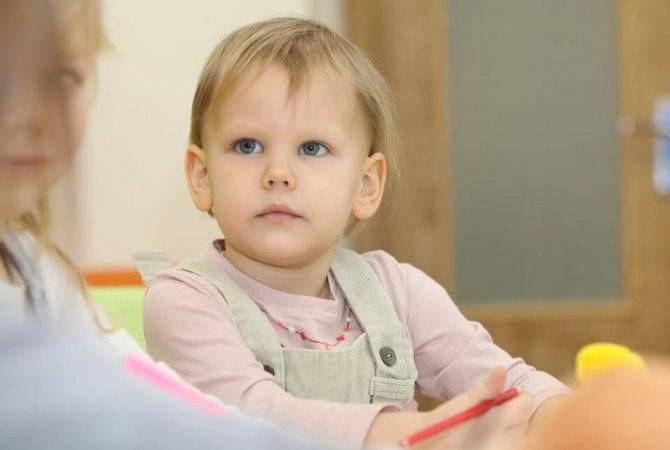
Pronunciation may be incorrect or unformed because:
- the child is still too small to pronounce, simply skips the phoneme, says not “fox”, but “isa” (mastering the sound “L” occurs at about 4 years, recognition of hardness and softness – at 6 years);
- the tongue is placed incorrectly (interdental pronunciation is clear, but distorted);
- the tongue is lowered (bilabial pronunciation is typical for the English, often observed in children raised in interethnic families);
- the tongue is relaxed, and the lower lip actively moves ("B" appears).
In the cases described above, articulation is impaired due to a defect in the position of the tongue in the mouth. Also, a pronunciation defect is a consequence of the fact that a distorted air flow is formed due to the incorrect position of the end or middle of the tongue:
- the lips move when producing sound, not the tongue;
- the end of the speech organ descends rather than rests on the upper incisors;
- the middle of the tongue bends upward, and the end drops (normally it should be the other way around).
To correct the described defects of the articulatory apparatus, several sessions with a speech therapist are sufficient. But if the cause of distorted pronunciation is dysarthria caused by pathologies of the nervous system, then a systemic and multi-stage correction is required.
Causes of impaired pronunciation of the sound l
There are several reasons when the pronunciation of “l” is not formed or is broken:
- The baby has not yet learned to say this sound and he simply skips it: for example, “even” instead of “rain.” At the age of 4-5 years, children have already mastered it, and by the age of 6, the child can no longer just talk, but can already differentiate a hard sound from a soft one;
- interdental pronunciation is characterized by incorrect positioning of the tongue, although acoustically it appears clearly;
- bilabial pronunciation: the tongue lies on the “bottom”, which is characteristic of the sound of the English language. This happens when a child has to communicate in several languages in the family;
- a mobile lower lip and a relaxed tongue - it turns out “v” instead of “l”: “development” - “fork”;

In these cases, articulation disorders are explained by an incorrect pronunciation algorithm, namely, the position of the tongue is not formed. There are also violations when differentiation is impaired due to improper breathing, incorrect position of the tip of the tongue, its middle:
- sound formation occurs through the lips, not the tongue;
- the tip of the tongue goes down instead of resting on the incisors;
- the middle of the tongue is raised, and the tip of the tongue is lowered, but the opposite is necessary.
The described disorders are due to the characteristics of the articulatory apparatus. In these cases, automating the correct sound l will take literally a couple of sessions with a speech therapist. You can also quickly deal with this at home. If sounds are produced for dysarthria associated with organic, functional disorders of the central nervous system, a step-by-step systemic production and automation of the sound l is necessary.
Articulation exercises
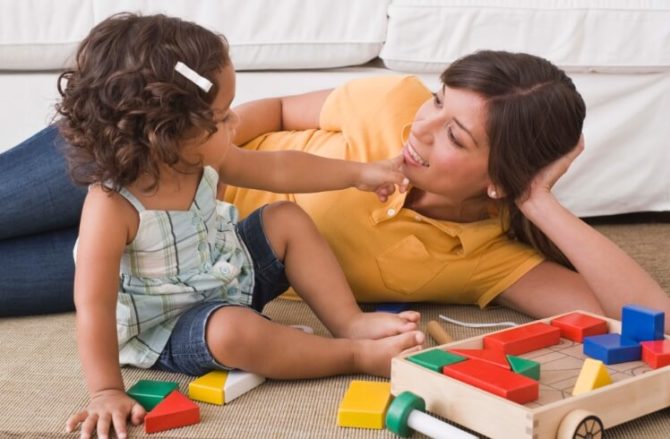
For any form of lambdacism, before the main set of corrective classes, it is necessary to take a course of articulatory gymnastics that improves the mobility of the speech organs. Each exercise is performed for 5 seconds, training takes place daily, 2 times a day.
- "Hammock". Place the end of the tongue against the upper incisors and bend down. Hold in this position while counting down the seconds.
- "Yummy". Relax your tongue so that it becomes wide. Lick your upper lip up and down. The lower jaw should not move.
- "Turkey". Perform the same movements as in the previous case, only faster. At the same time pronounce “bl-bl-bl-bl”.
- "The horse is galloping." Relax your tongue, making it wide. Click it on the palate near the upper incisors. Do not move your lower jaw.
- "Swing". Smile widely with your mouth slightly open. Alternately rest the end of the tongue on the upper and lower incisors.
- "Fungus". Press your tongue against the palate so that the lingual frenulum is stretched.
You need to train for at least 2 weeks. After training, you can begin the exercises prescribed by the speech therapist to establish the sound L.
Articulation gymnastics
The main method for correcting the pronunciation of the sound “l” is articulatory gymnastics. As a rule, its duration does not exceed 15-20 minutes; the exact time depends on the age of the child. Articulatory gymnastics consists of step-by-step execution of certain elements that should not only be effective, but also arouse interest in the baby.
Articulation gymnastics includes:
- exercises used to develop speech breathing;
- pronunciation automation tasks.
Errors when trying to pronounce a sound
When setting the phoneme, some children make mistakes that nullify the effectiveness of the lessons. Most often, errors are caused by incorrect position of the speech organs, but this problem is not difficult to deal with.
Training may not produce results because:
- the tongue is too deep in the mouth, so it is pronounced “Y” (not “bow”, but “yuk”);
- lips are placed incorrectly, causing the sound to be distorted;
- when pronouncing, you take a breath (with the buccal pronunciation you hear “F”, with the nasal pronunciation you hear “N”);
- there is a replacement with the already used “R” (not “bun”, but “burka”).
Making the sound L by imitation
Parents themselves, standing in front of a mirror, can show their children correct articulation. When pronouncing a consonant:
- the lips are in a smiling position, the mouth is slightly open, the upper and lower teeth do not touch;
- the end of the tongue is directed upward, pressed against the back surface of the gums above the upper incisors;
- the air is exhaled from both sides of the tongue and rushes into the cheeks.
Children should follow their parents' steps while looking in the mirror. However, this method of training is not suitable for young children who are not yet capable of imitation. In this case, other methods of setting the sound L are used.
How to make the sound "l"
The very first thing to start with is to tell and show the student the correct pronunciation of the sound, and how the tongue and lips behave. There are many free photos and videos available online for this purpose. Many methodological works have been developed on how to teach a child to say the letter “l”. To put an "l" you need to work on your breathing and articulation.
At home, you yourself can explain how to correctly pronounce this or that sound. Just think about how you do it, and then show it. Children always learn better from the example of others. Just show the principle and let the child repeat after you.
Problems with speech production in children are common. The lessons will help the child develop auditory perception of the sound “l”.
It is important to breathe correctly and position your tongue and lips. Breathing exercises are designed as a game.
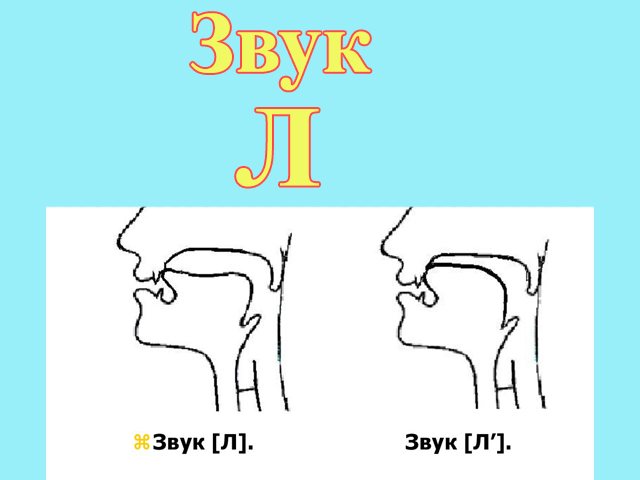
The simplest exercises will be interesting to the baby. Having fun outside can be educational. While walking, you can play with dandelions, offering to blow off all their “feathers” and blow soap bubbles.
At home you can play with a lit candle, blowing it out, or a match, but only under the strict supervision of adults, and various similar games for blowing air. Such games will interest your baby and will at the same time be educational in nature.
It is necessary to develop the child’s fine motor skills. It is necessary for speech correction, intellectual and physical development.
Speech therapy production of the sound L
The following techniques for producing the consonant sound L are used:
- articulation training;
- development of speech breathing;
- pronunciation automation.
Each technique listed must be included in all home activities. Moreover, it must be taken into account that children under 4 years old should not train for longer than 20 minutes, children 4–6 years old should not train for longer than 25 minutes.
Classes are conducted in stages. Before starting speech development classes, you need to practice breathing for a few minutes:
- take a short second breath;
- then slowly exit calmly for about 5 seconds.
To train your breathing, you can do the following exercises:
- play with a pinwheel;
- “stop the horse” - relax your lips as you inhale, then exhale the air so that you get a “prrrr”;
- “inflate a balloon” - lie on the floor, put your hand on your stomach to feel how your stomach inflates when you inhale and deflates when you exhale;
- guess fruits and flowers with your eyes closed, deeply inhaling their smells;
- blow a feather into an improvised gate, exhaling air through pursed lips.
Also, you may be interested in learning how to pronounce the sound R at home.
What are the reasons for the incorrect pronunciation of L?
Until the age of 4, the speech apparatus is not adapted to pronouncing this sound, so lambdaism at this age is considered a variant of the norm.
There are several reasons why a child speaks incorrectly:
- Improper breathing during speech.
- Disturbances in the development of speech hearing - the child has difficulty hearing the speech of other people and does not perceive meaning well.
- Insufficient development of the articulatory apparatus, weakness of facial muscles and tongue. These muscles play a leading role in the pronunciation of sounds.
- Deviations in the structure of the hyoid ligament (frenulum) - speech disorders are possible if the ligament is short.
Improper breathing can be due to several factors:
- The child's lung capacity is reduced.
- The respiratory muscles are weak, so the child cannot speak loudly.
- When exhaling, the air stream comes out in jerks, so it becomes difficult to finish a long sentence.
- Incorrect distribution of air, resulting in inhalation starting in the middle of the word.
Mechanical method of installation
In speech therapy, the production of the sound L by a mechanical method is practiced. The following actions apply:
- the preschooler bends over, stretches his head forward, strains the neck-shoulder girdle, and in this body position tries to draw out a consonant;
- the speech therapist places the index fingers on the patient’s neck, places the ring fingers with light pressure in the area of the corners of the jaws, while the patient tries to pronounce the phoneme;
- with labial-dental pronunciation, the preschooler needs to move his lips forward and hold them in this position as air escapes;
- with nasal pronunciation, the speech therapist should teach the patient to push the tongue towards the teeth so that the air exits along the sides of the speech organ through the corners of the lips;
- the mechanical version of the training involves the use of probe No. 4 (the sound L is set using speech therapy massage with probes, by fixing the position of the tongue, in which the air comes out in lateral jets).
Setting [L] with mechanical assistance
Setting up the sound [L] is difficult for a child to perform; it must be done in stages.
In this case, the following tasks may help:
- The preschooler should bend down, stretch his head forward, and tense the muscles of his shoulders and neck. In this position, you should try to stretch out the sound [L].
- Sometimes mechanical assistance can be used to deliver sound: put the index fingers on the neck, and bring the ring fingers closer to the corners of the jaw, pressing lightly. At this moment the child should say [L].
- If a preschooler has a labiodental pronunciation, then you should use the following method: the child moves his lips forward, holds them for a moment and pronounces [L].
![Producing the sound [L] to a child in stages. Articulation gymnastics, speech therapy exercises, pronunciation lessons with pictures](https://supdetki.ru/wp-content/uploads/postanovka-zvuka-l-rebenku-poetapno-artikulyacionnaya-gimnastika-logopedicheskie-uprazhneniya-uroki.jpg)
- If nasal pronunciation is observed, then you need to ensure that a stream of air comes out through the corners of the lips. The child needs to be taught, using the exercises described above, to push the tongue forward towards the teeth.
Articulation gymnastics for the sound L
It is the main stage of setting the sound L, carried out in stages. Classes, depending on the age of the patient, last from 15 to 25 minutes.
- Warm up. Move your tongue, imitating the clatter of horse hooves. The “Sail” exercise is also effective: the tongue rises vertically in the mouth, is held in this position for 10 seconds, with each session the holding time increases (maximum time - 40 seconds). Warm-up strengthens and makes the tongue muscles more mobile.
- From "Y". The game "Steamboat" is played. The mouth stretches into a smile, the tongue rests on the teeth. You need to bite the relaxed end of your tongue and say “y-y-y” or “oo-oo-oo.” It will turn out “l-l-l”.
- Setting from the soft sound “L”. It is easier for children to pronounce a soft phoneme than a hard one. After all, the labial muscles do not tense so much.
- From "A". You need to smile and, biting your relaxed tongue, pronounce a drawn-out “A”. It will come out “al-al-al.” Next there should be practice of “ala-ala-ala”, and at the last stage “la-la-la”.
- From "B". You need to teach your preschooler not to move his lower lip. He should hold the lower lip down for 5 seconds, then return it to the original position with the upper lip. If the patient cannot cope with the task on his own, then it is necessary to help him: put a finger under his lip, move it up and down.
The feasibility of speech therapy classes
Some parents do not think about how to teach their child to say the letter L. They do not consider the defect to be something serious, but in adult life it will become the basis of complexes and worries.
Important! It is better to correct speech disorders in preschool age, then the process will take a little time.
Games for the development of coherent speech in the middle group - conducting educational activities
If parents do not know how to correctly teach their child to pronounce the letters L and R, then they should contact a specialist. A speech therapist will be able to correct this problem and develop the desired pronunciation.
How many lessons does it take to produce sound [l]
It is impossible to say with certainty how many lessons will be required to eliminate the defect. Sometimes sound production takes one session, in other situations it will take more than 30-40 meetings.
It all depends on the characteristics of the child, his motivation and the interest of the parents. Learning to pronounce the sound [l] is not so easy, since a preschooler gets used to a certain stereotype. Due to their age, it is still difficult for children to perceive learning activities.
How does an individual sound production lesson work [l]
The speech therapist performs sound production only after the student performs articulatory gymnastics well. The complex is performed strictly in front of a mirror. Afterwards they do breathing exercises and perform speech hearing tasks.
How does an individual lesson on sound automation work [l]
The speech therapist conducts individual lessons on automating the sound [l] only after calling an isolated pronunciation. At such lessons, the specialist develops the lexical and grammatical structure of speech, phonetic and phonemic hearing.
To do this, use different games and simulators. Modern speech therapists use computer games. Parents are required to participate in the process and carry out the specialist’s tasks at home.
Important! The duration of the lesson for preschool age is approximately 25 minutes. Physical minutes are required to switch activities.
Automation of sound L

The formed pronunciation needs to be consolidated and pronounced constantly. If a preschooler does not know how to read, then pronunciation is reinforced by repeating it to the parents.
First, syllables are pronounced in which the consonant comes before the vowel: la, lo, le, li. Then, where the vowel comes first: ol, al, ate, il. After which they move on to pronouncing words where the consonant is at the beginning, middle and end, where the phoneme is softened and combined with other consonants.
Next, they practice the pronunciation of phrases and phrases where each word or most words contain syllables:
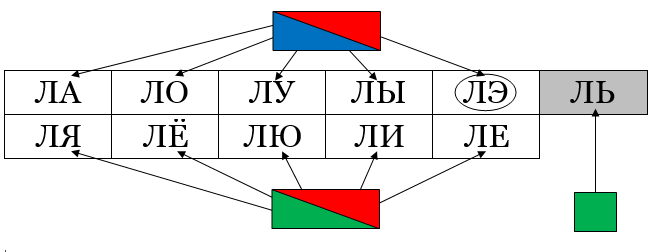
- straight lines - la, lu, lo, le, ly;
- reverse - al, ol, st, yl, ate, yul, yal, il;
- with joined consonants - cla, sla, bla, vla, pla, shla, gla, fla (similarly with the vowels “u”, “o” and “y”).
Making the sound L hard takes a lot of time. Usually you have to repeat the same words and phrases with children for several days.
When the phoneme in words and phrases has been worked out well, you can move on to rhymes, pure and tongue twisters, nursery rhymes, and riddles.
You can find a variety of speech therapy material on the Internet and bookstores. Texts must be spoken slowly and clearly, without distorting the sounds. If the pronunciation is incorrect, the sentence is repeated again.
If at the initial stage of reinforcement classes the patient repeats syllables, words, phrases after the speech therapist, then he must then independently remember and pronounce words and sentences. And the specialist only gives tasks:
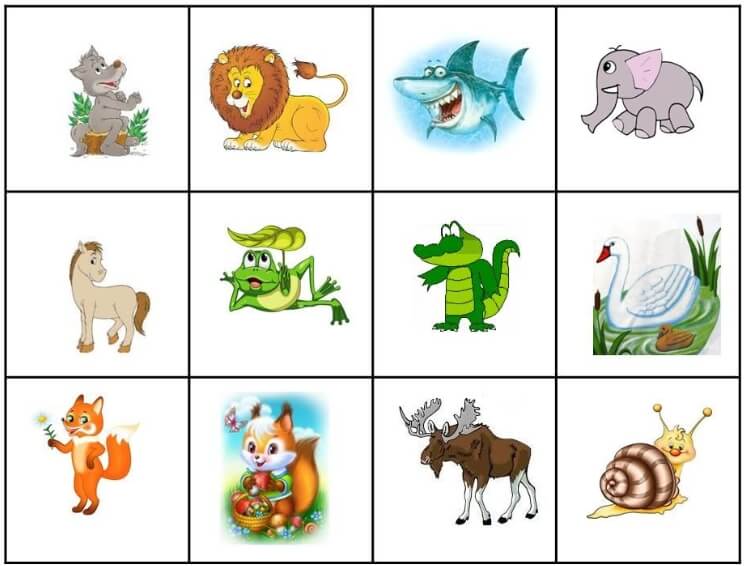
- list the names of animals that include the phoneme being worked on;
- names of plants;
- names of food products;
- names of household items.
If the pronunciation of a hard phoneme is difficult, then you can start reinforcement lessons with soft syllables:
- straight lines - la, lyu, le, li;
- reverse - yal, yul, al, ol, spruce, ul, yl;
- with connected consonants - pli, ple, plu, plya (similarly with the consonants “s”, “f”, “k”, “g”).
Next, the soft phoneme, like the hard one, is fixed in words, phrases, and sentences. Pure twisters and tongue twisters, poems and riddles are used. Parents can compose pure sayings themselves together with their children.
Automation
A number of articulation exercises carried out require consolidation and constant pronunciation. If the child does not yet know how to read, parents should pronounce the words themselves and then ask their children to repeat them. This way the preschooler better assimilates spoken sounds.
First, the syllables “l” with vowels are pronounced: l-a, l-o, l-i; then vice versa: o-l, a-l, i-l, e-l. Then the full words are spoken. “L” is at the beginning, middle, end of a word, softened or made hard, next to other consonants, and so on.
Next, you should pronounce whole exercises, it is desirable that there is an “l” in each word: the forest has put on foliage, the fox loves summer.
We repeat and learn poems and tongue twisters. When working, all phrases and sentences must be pronounced slowly and clearly to avoid distortion. If your child makes a mistake, go back to the beginning of the sentence and repeat it all over again. Praise him, this will help him feel confident. Repeat everything several times.

These simple rules should be followed to teach your child to pronounce the letter “l” automatically.
Speech therapy classes: consolidation of pronunciation
Speech therapy classes in a playful way arouse great interest among children. As a result, it is possible to achieve positive results faster. The most frequently used games are:
1. "Path". A path is drawn on a piece of paper from the written letter to the drawn object, the name of which contains this letter. The patient moves his finger from the letter along the line to the drawing, pronouncing the problematic consonant, and at the end of the path he names the drawn object.
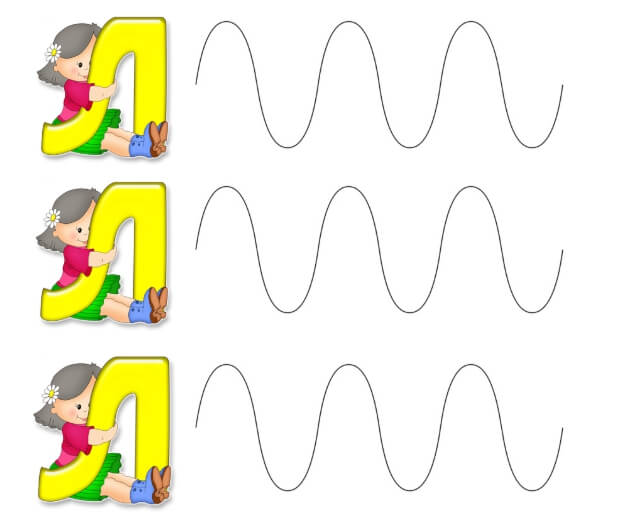
2. “The Fox and the Koloboks.” A figurine of a fox and 10 koloboks are cut out. The speech therapist asks the patient to name a specific word. If the task is completed successfully, then the bun runs away from the fox; if not, then the fox eats another bun.

3. Subject cards. The cards depict objects whose names contain a problematic consonant. The preschooler is asked to name the depicted object.
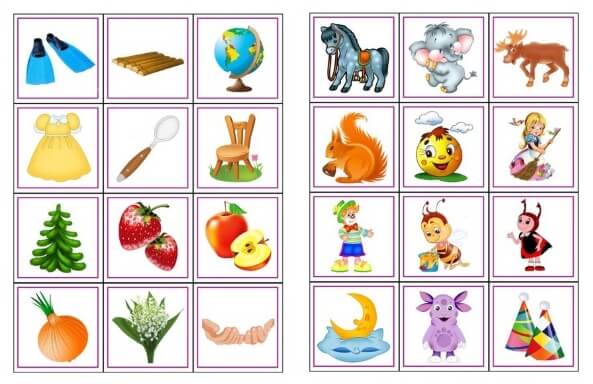
4. Speech therapy cards with the sound L.

Usually, parents cope with all of the above activities on their own. But if a lot of time has passed, and speech therapy training at home has not yielded a positive result, then the help of a speech therapist is required.
Sound correction [l] at home
Speech disorders occur for various reasons. In the case where the child does not speak only one or two sounds, parents can try to correct the defect themselves.

Classes with a speech therapist will help correct any speech problems
How to teach a child to say the letter L hard
With dyslalia, children have problems only with sound pronunciation. Violations arise due to structural features of the articulatory apparatus or insufficient muscle preparation.
For the sound [l], the upper rise of the tip of the tongue is important. This is difficult to do with a short hyoid frenulum. Therefore, it must first be trimmed by a dentist. Only surgery will solve this problem.
It’s easy to check the ligament: you need to ask the child to touch the upper teeth with the tip of his tongue. Sonoras ([l], [r] and their soft pairs) appear by the age of five and until that time there is nothing to worry about. At three years old, the child’s articulatory apparatus is still developing.
Important! There is no need to rush and demand that children pronounce all sounds from an early age. Otherwise, you can provoke the development of a defect.
At home, you can try to correct the incorrect pronunciation of the sound [l] yourself. This is only allowed in the case of dyslalia. Sometimes this problem can be confused with dysarthria, which requires work with a speech therapist.
With dysarthria, the mobility of the muscles of the articulatory apparatus is impaired. A similar problem is expressed in hypertonicity or hypotonicity. Often the tongue of such a child is bunched up in the mouth or is too relaxed. It will be difficult for your baby to perform fine movements and switch from one position to another.
Correcting incorrect pronunciation may take up to one year. You need to work with your child every day - this will speed up the process. It is necessary to follow the sequence of stages and not rush.
Sound production
The mechanical method is often used in speech therapy. It requires a special probe in the form of a wire frame or a spatula. The child opens his mouth wide, pronounces “YYYYYY” in a drawn-out manner, and at this time the adult lifts his tongue with an instrument.
It is easier to teach a child to pronounce a sound from the interdental position. To do this, the preschooler is asked to bite the tip of the tongue and pronounce the sound [s] (YYYYYYY), and then gradually remove the tongue behind the upper teeth.
You can pronounce [l] in the interdental position immediately with syllables. Gradually we are moving away from this situation. Automation begins only with direct syllables: LA, LO, LY, LE.
Important! You cannot rush to move on to words, otherwise defective pronunciation will become entrenched.
Speech development in the middle group of kindergarten - norms and features
Sound Automation
After the correct pronunciation has been worked out in forward and backward syllables, they move on to words. To facilitate perception, visual material is used in the form of pictures and special games. For example, a child is asked to show objects with the sound [l].
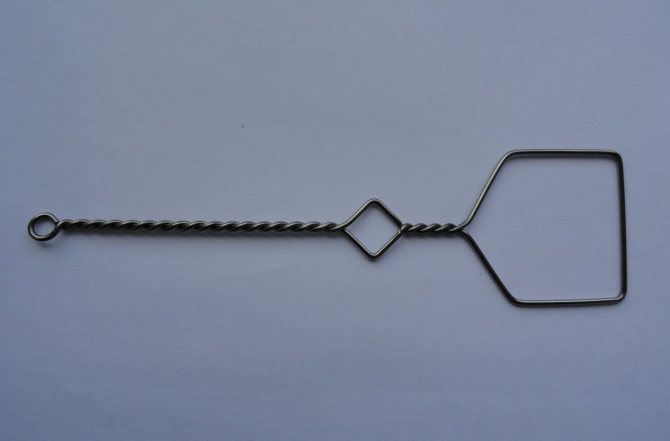
Syllables can be pronounced using a probe
It is difficult to teach a preschooler to exercise self-control. Therefore, you need to constantly work with him. It is enough to devote less than half an hour to work and the effect will not be long in coming.
Parents should understand that there is no method that will give quick results. Only constant training will help you consolidate correct pronunciation.
Songs and rhymes
To facilitate the automation process, different lexical material is used. Pure sayings and poetic forms are easier to remember and the child likes to reproduce them.
You can talk to a preschooler about different topics. This will make it easier for him to get used to the correct pronunciation.
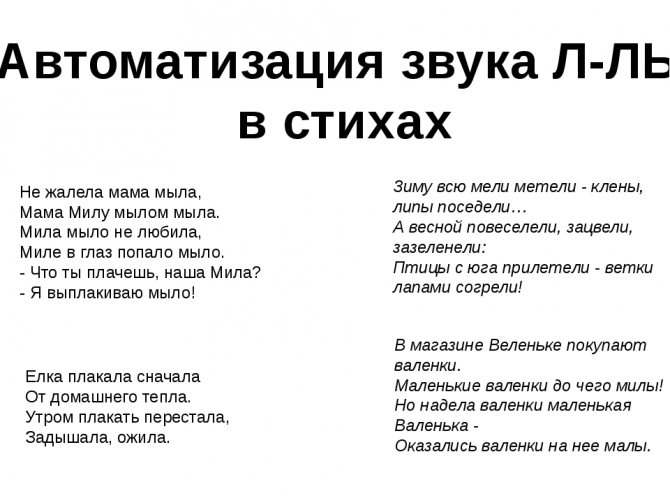
Example of poems for sound automation [l]
The main condition for effective classes is the interest of the student. Therefore, everything is carried out in a playful way. The more varied the material, the better for the baby.
Tongue Twisters
The most difficult thing is to introduce sound into independent speech. To facilitate the process, tongue twisters using the sound [L] are used. They contain words that allow you to practice sound pronunciation in different positions.
For example, “There are pins at the Christmas tree”, “Will in the field”, “I went to Luka’s tray, Luka bought onions from the tray”, etc. Gradually, the child is asked to pronounce each tongue twister faster. Much attention is paid to correct pronunciation.
Articulation exercises
Learning to pronounce a sound correctly begins with articulatory gymnastics. Speech therapy exercises for quickly setting sound [l]:
- The wide tongue lies behind the lower teeth, the child pronounces “YYYYYYYY” in a drawn-out manner.
- Lick your upper lip with the tip of your tongue.
- Click your tongue.
- Open your mouth wide and run your tongue along the inside of your teeth.
- Run the tip of your tongue across the roof of your mouth.
The complex is performed every day. In order for a child to learn to pronounce a sound correctly, he must do all the exercises correctly. In this case, it is important to monitor the immobility of the jaw.
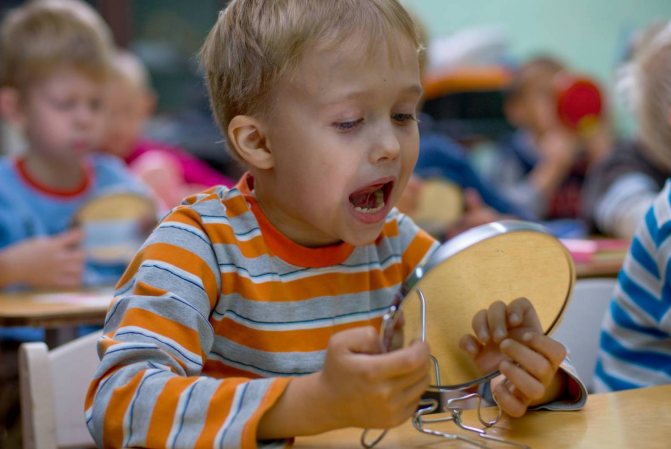
Articulation gymnastics is performed strictly in front of a mirror
After all the movements are easy to perform, move on to the next stage - producing a solid sound [l]. To do this, different techniques are used. It is impossible to say in advance which one will suit a particular child.






